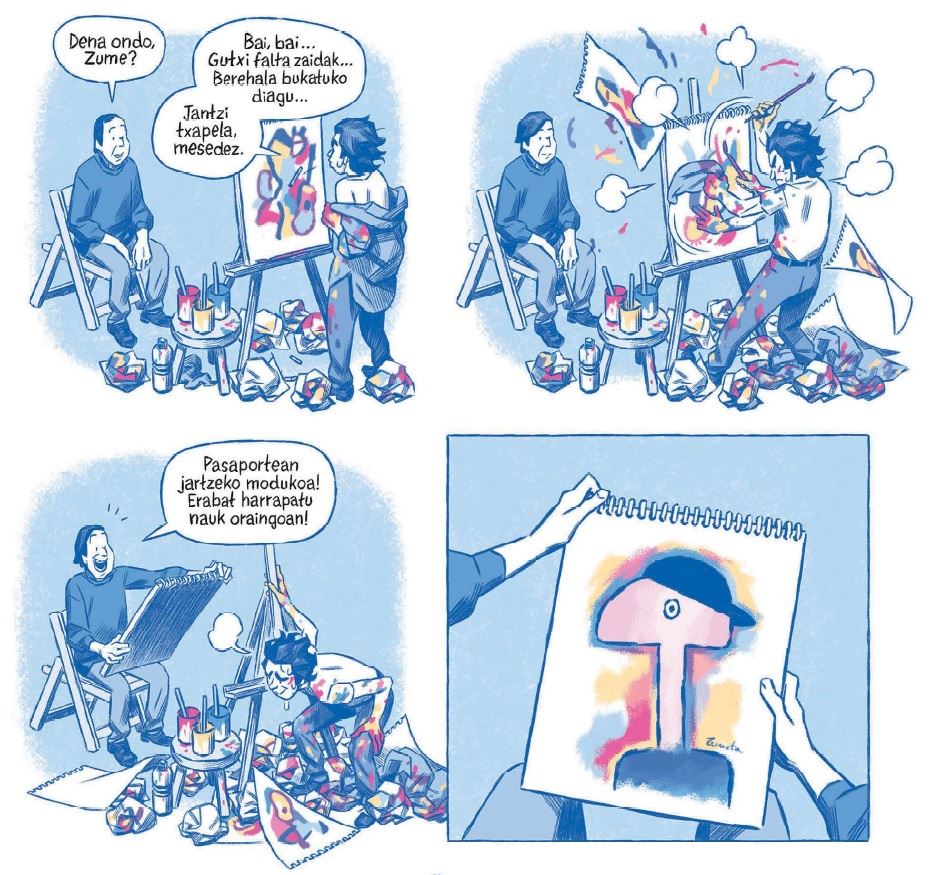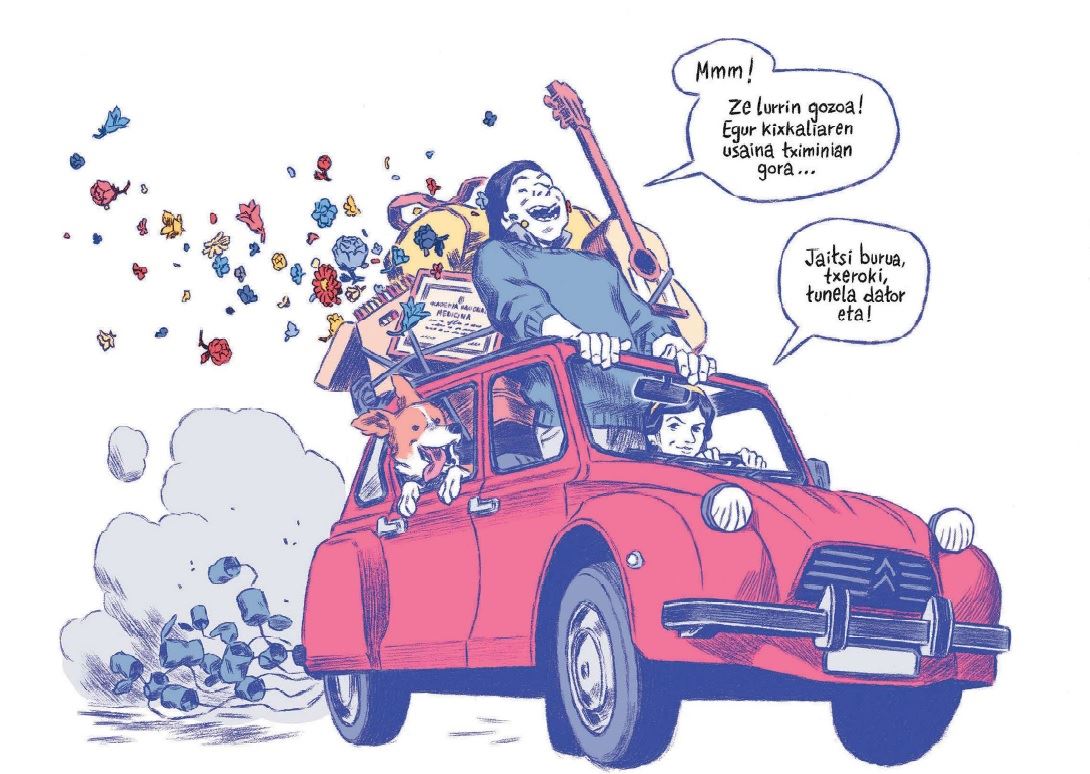Euskaraz irakurri: Harkaitz Cano: “Laboa harrapaezina denez, haren izpirituari heltzen saiatu gara”
How to summarize Mikel Laboa in a comic, when he was the creator of a complete universe? In what way can the life and influence of someone who expanded a language, the music itself and the minds of their listeners be enclosed and condensed on paper? It is impossible, of course, and that is why in Ni ez naiz Mikel Laboa (Elkar, 2022) the scriptwriters Unai Iturriaga and Harkaitz Cano and the cartoonist Joseba Larratxe have escaped the norm, as befits the heterodox Mikel Laboa.
The shortlist delivers a comic deeply laboan: daring, lyrical, playful, exciting, symbolic and devoid of epic, far from any type of hagiography, but full of knowledge and nods to the life of the musician from San Sebastian and his environment.
we have talked with Harkaitz Cano to know what it is and what it is not Mikel Laboa was born.
What is the origin of Ni ez naiz Mikel Laboa? What did you want to do and, as the title says, what did you not want to do?
Unai Iturriaga was commissioned by the Mikel Laboa Chair (University of the Basque Country), and it was he who contacted me and Joseba.
With Laboa it happens as with Proust’s madeleine: each one has their own, and their songs take us to specific and deep places, usually to symbolic spaces and exciting memories.
As Laboa is vast as a whole, we decided to try to capture its spirit and, specifically, its funniest side on the one hand and the most experimental on the other. And, inevitably, where there is playful humor and experimentalism, there will also be risk.
What did we not want? A usual biography or a chronological chronicle, among other things because Mari Sol Bastida already did that in an unbeatable way in her autobiographical memoir.
As is well reflected in the spectacular scene set in Zumeta’s studio, there is “an endless number of Laboas”: we have heard thousands of stories about him and his musical work is extremely open, lacking any rigidity.
On the one hand, we wanted to convert his songs into images: potential for catharsis, a chronicle of a time, an apology for simplicity, surrealism, his instinct to transcend languages and genres… His songs have many edges.
That opening that you mention is the most defining feature of Laboa, and today it remains more alive than ever. To speak of the best known case, “Txoria txori”; You can sing the same song as a lullaby, at a party, at a funeral or in a stadium…
I would say that we have approached the most playful aspect of Laboa because it is the one that works best in the comic. That is why the story begins in the key of a western. And, paradoxically and almost unintentionally, his songs and his journey have led us towards the axes of his biography.

‘I am not born Mikel Laboa’ (Elkar, 2022)
Is about a very laboan comic about Laboa. What aesthetic and stylistic features share, from your point of view, the work of Mikel Laboa and Ni ez naiz Mikel Laboa?
On the one hand, we have tried to make the most of the possibilities of the comic: the very colors that Joseba has chosen, which on the other hand fit very well with Zumeta’s palette, tell a story by themselves.
He has created three or four Laboas of different ages, who move between Tintin and Don Quixote, to explain it in some way.
I’d say the comic has different layers: if there’s someone who doesn’t know anything about Laboa, the comic will give them some handholds to hold on to, and anyone with a better understanding of its time and context will find some nice winks to enjoy.
How has the six-handed creation process been?
The comic has been designed in three ways and drawn with two hands. To begin with, we met in Lekeitio –where else?– and we established a roadmap. And, as Unai says, the first step on that roadmap was to break the compass.
We agree on the essential fragments, and distribute the work.
In any case, as the drawing progressed, Joseba has become a scriptwriter, since, as the project has taken quite a long time, we have been able to share the material and review it carefully.
The truth is that there are some passages that I no longer know who wrote them… It has been a work carried out truly in common.
Beyond Laboa, you have created a story about a time and a social group. The family and contemporary creators are very present.
The artist is always portrayed as lonely and enlightened, and we don’t totally agree with that. Laboa was Laboa because the yearning of the people around him was what it was, because there was tremendous collective work between different disciplines and an almost shamanic connection was achieved with the public through Ez Dok Amairu, and also because he had around him indispensable accomplices and friends as is the case of Mari Sol Bastida or Zumeta herself, who made so many covers and posters for her.
On that side, it is also a tribute to an entire generation, and the book is peppered with glimpses of many artists.

‘I am not born Mikel Laboa’ (Elkar, 2022)
Mari Sol Bastida and Mikel Laboa traveled a lot at a time when traveling was not so common, Mikel lived and trained in Barcelona… There, in addition to discovering a song model exportable to the Basque Country, he also worked as a child therapist and neuropsychiatrist, and that left its mark both in his life and in his work. In the comic there are also small samples of all this.
On pages 38 and 39 an audience made up of a multitude of familiar faces appears expectantly, waiting for Laboa to sing. What public, what faces, have you imagined on the other side of the paper, when writing and drawing?
These pages serve another function besides being a fun exercise in “Where’s Wally?” and “Who is who?”: they represent stage fright, since whoever goes on stage feels that the whole world is looking at them, that they are in front of those who love them, but that their deceased and those to whom are also watching in some way. those he admires, and who is indebted to all of them.
What record or song by Mikel Laboa would you recommend to the reader of Ni ez naiz Mikel Laboa Or who, induced by the book, wants to delve into his work?
I dare not choose just one, at the end of the comic we have put a “soundtrack”, and any of those songs could accompany it.
Also, they are not all from Laboa; there are also songs by Guillermina Motta and Francesc Pi de la Serra, for example, and there is also Atahualpa Yupanqui. The comic begins with a letter from the latter.
Source: Eitb
Mario Twitchell is an accomplished author and journalist, known for his insightful and thought-provoking writing on a wide range of topics including general and opinion. He currently works as a writer at 247 news agency, where he has established himself as a respected voice in the industry.











